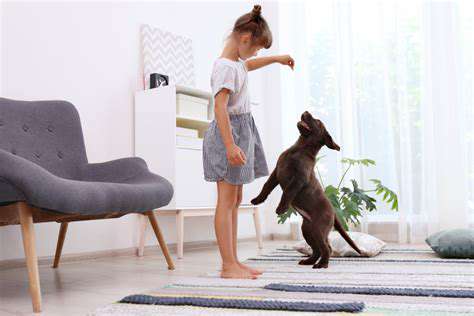Obedience Training for Energetic Puppies: Channeling Their Energy
The Importance of Early Socialization and Training
Understanding the Significance of Early Socialization
From the moment puppies open their eyes, their world begins expanding at a rapid pace. Early socialization plays a crucial role in determining whether they'll grow into confident companions or anxious adults. The window between 3 and 12 weeks represents a critical developmental phase where positive experiences with diverse environments, sounds, and beings create neural pathways that last a lifetime.
This formative period isn't merely about exposure - it's about creating meaningful connections. When puppies learn proper canine etiquette through supervised playdates, they develop an understanding of boundaries that prevents future conflicts. The difference between a dog that cowers during thunderstorms and one that sleeps through them often traces back to these early weeks.
Building a Strong Foundation for Obedience Training
Socialization and training form two sides of the same coin. A puppy accustomed to varied stimuli focuses better during lessons because unfamiliar sights and sounds don't trigger panic responses. This mental flexibility becomes particularly valuable when teaching complex commands in distracting environments like parks or busy sidewalks.
The most successful trainers understand that every interaction teaches something. Whether it's waiting patiently for meals or resisting the urge to jump, these micro-lessons accumulate into reliable behavior patterns. Reward-based methods prove especially effective because they transform learning from obligation into joyful collaboration.
Addressing Potential Challenges in Energetic Breeds
High-energy breeds like Border Collies or Jack Russell Terriers possess intelligence that demands constant engagement. Without proper channels, their mental and physical vigor manifests in shredded furniture or obsessive behaviors. Early intervention helps redirect this energy into constructive outlets before problematic patterns solidify.
Owners often misinterpret destructive chewing as disobedience rather than the boredom cry it represents. Providing appropriate chew toys alongside regular training sessions satisfies both physical and psychological needs, preventing the development of harder-to-break habits in adulthood.
Tailoring Training to the Breed's Needs
Effective training requires understanding genetic blueprints. Herding breeds thrive when given jobs that engage their natural instincts, while scent hounds need activities that challenge their extraordinary noses. This specialization explains why one-size-fits-all approaches frequently fail.
Consider the difference between training a Greyhound versus a Labrador. The sighthound's training should accommodate their chase instinct through controlled recall exercises, while the retriever benefits from object-focused games that satisfy their carrying impulse. These breed-specific adaptations make learning feel intuitive rather than forced.
The Role of Positive Reinforcement in Training
Modern behavioral science confirms what intuitive trainers always knew - punishment creates fearful compliance while rewards foster willing cooperation. The neurotransmitter dopamine not only reinforces desired behaviors but actually enhances learning capacity, making treat-based methods neurologically superior.
This approach proves particularly transformative for energetic dogs. When they discover that calm focus earns rewards, they voluntarily regulate their excitement. The resulting self-control stems from internal motivation rather than external suppression, creating more reliable behaviors in unpredictable situations.
Consistency and Patience in the Training Process
Canine learning follows the same principles as mastering a musical instrument - brief, daily practice yields better results than marathon weekend sessions. This regularity helps cement neural pathways while preventing frustration from information overload.
Patience becomes especially crucial with high-drive breeds. Their enthusiasm sometimes overrides focus, requiring trainers to break lessons into smaller segments. Celebrating incremental progress maintains motivation for both species involved in the training partnership.
Addressing Potential Challenges with Energetic Puppies

Identifying and Categorizing Challenges
Effective problem-solving begins with distinguishing between symptoms and root causes. A puppy chewing shoes might indicate teething discomfort, separation anxiety, or insufficient exercise. Accurate diagnosis determines whether the solution involves frozen chew toys, desensitization training, or longer walks.
Developing Mitigation Strategies
Solutions should address both immediate concerns and underlying triggers. For a puppy barking at passersby, short-term redirection with treats combines effectively with gradual exposure therapy to create lasting change. This dual approach prevents temporary fixes that collapse under stress.
Assessing Resource Requirements
Realistic planning accounts for time investments as much as financial ones. Training an energetic breed often requires dedicating 90+ minutes daily to combined physical and mental exercise. Those unable to meet these demands might consider lower-energy companions.
Establishing Clear Communication Channels
Consistent verbal cues and hand signals prevent canine confusion. Families should agree on standardized commands to avoid teaching down as both a position command and a get off instruction, which creates unnecessary conflict.
Implementing and Monitoring Solutions
Behavioral journals help track progress objectively. Noting variables like exercise duration, training frequency, and environmental triggers reveals patterns invisible in daily interactions. This data-driven approach prevents subjective assessments from derailing progress.
Evaluating and Adapting Strategies
When plateaus occur, skilled trainers adjust techniques rather than intensifying failed approaches. A puppy struggling with stay might succeed with distance increments measured in inches rather than feet, rebuilding confidence through achievable challenges.
Addressing Unexpected Outcomes
Setbacks often reveal hidden variables. A previously housebroken puppy having accidents might signal medical issues rather than behavioral regression. This diagnostic flexibility separates effective trainers from frustrated ones, allowing for appropriate veterinary rather than disciplinary responses.

Read more about Obedience Training for Energetic Puppies: Channeling Their Energy
Hot Recommendations
- The Impact of Early Socialization on a Dog's Interaction with Other Animals
- Car Travel and Puppy Socialization: Making the Journey a Positive Experience
- The Importance of Early Environmental Exposure for Puppy Development
- Taking Your Puppy to the Vet: Positive Socialization Strategies
- Making Training a Positive Experience for Your Puppy
- Public Transportation and Puppy Socialization: A Step by Step Guide
- Safe Socialization: Allowing Others to Pet Your Puppy
- Helping a Puppy Who Struggles with "Stay"
- Positive Puppy Interactions: Making Meetings with New Friends Fun
- No Treats Needed? Training Basic Commands with Verbal Praise











